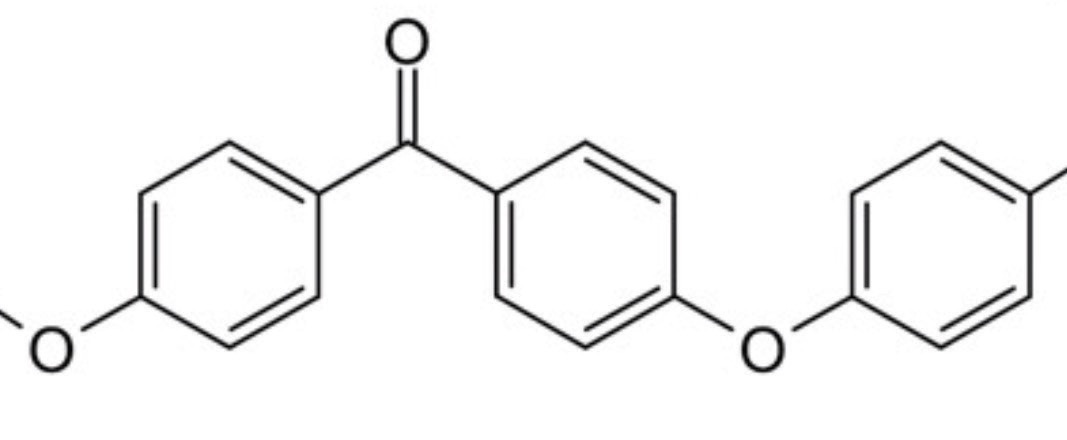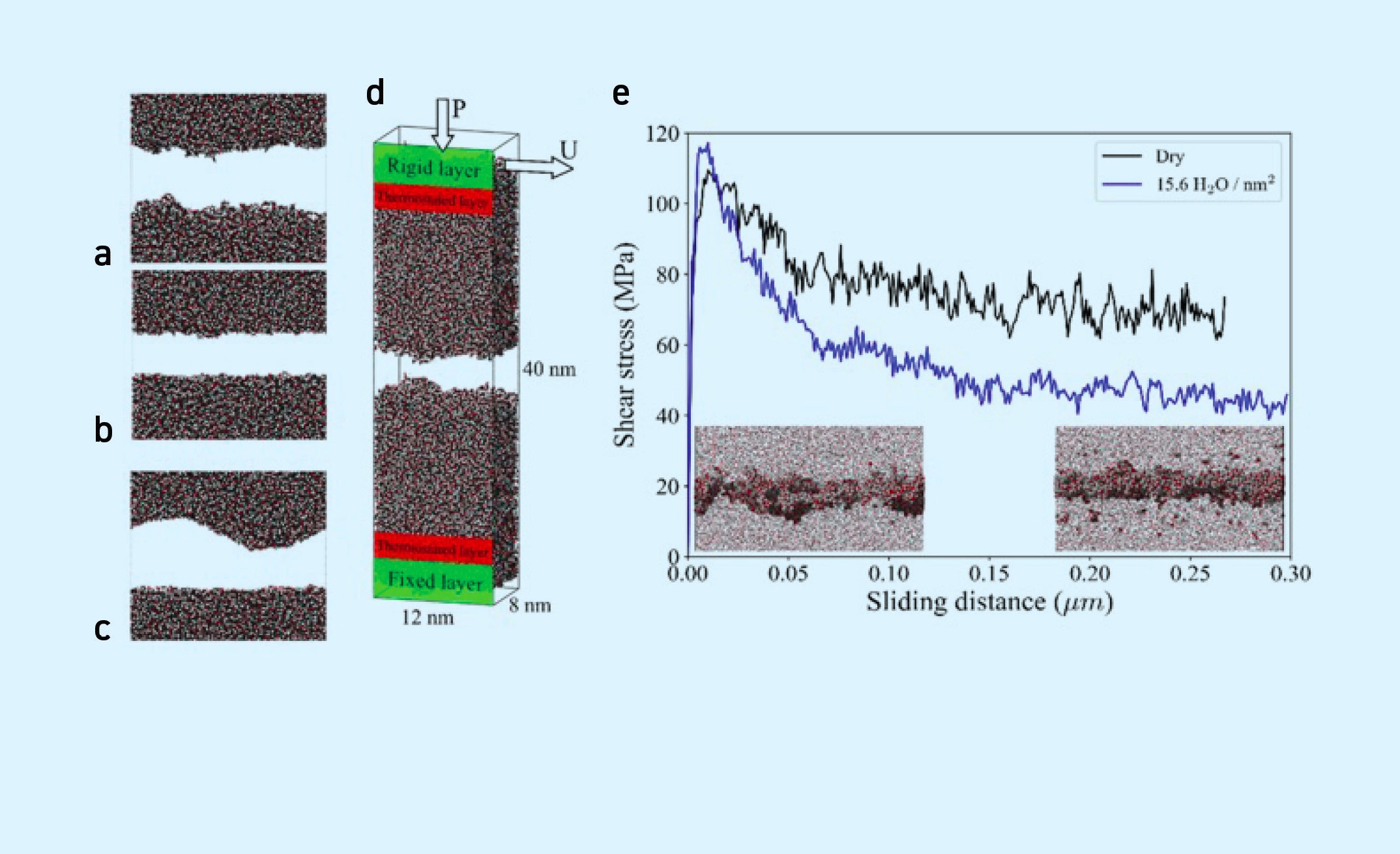PEEK performance
Drs. Wilfred T. Tysoe & Nicholas D. Spencer | TLT Cutting Edge August 2021
Closing the gap between nanoscale simulations, contact mechanics calculations and experimental measurements for a polymer with real-world applications.
Making machines from polymers is a highly attractive proposition. They are light, corrosion-resistant, often biocompatible and generally low priced. In particular, the high-performance semicrystalline thermoplastic, polyether ether ketone (PEEK,
see Figure 1) has shown considerable promise in tribological applications due to its thermal stability and excellent mechanical properties.
The frictional behavior of polymers is generally more complex than their metallic counterparts, however. Amontons’ law often is not obeyed, adhesion and viscoelastic behavior need to be considered, and sensitivity to thermal stress can be a serious problem.
 Figure 1. The molecular formula of polyether ether ketone (PEEK). Figure courtesy of Wikipedia.
Figure 1. The molecular formula of polyether ether ketone (PEEK). Figure courtesy of Wikipedia.
Predicting the tribological performance of polymers depends critically on understanding the way in which the real contact area varies under load and sliding, as well as having a value for the shear strength,
τ, of the adhesive junctions. This is far from trivial, since the mechanisms involved on a nanoscopic level are not completely understood, and factors such as the presence of moisture, lubricants or transfer films can totally dominate the behavior. One promising approach to untangling this problem is to use molecular dynamics (MD) simulations to model the polymer behavior. However, since MD calculations of complex systems are computationally very expensive, bridging the gap in length and time scales between MD results, and real tribological systems, has proven to be extremely challenging.
The challenge has been met by a group of collaborating researchers in Germany (Daniele Savio, Jannik Hamann, Pedro A. Romero, Christoph Klingshirn, Ravindrakumar Bactavatchalou, Martin Dienwiebel and Michael Moseler), drawn from the Freudenberg Co. in Weinheim, Germany; the Fraunhofer Institute IWM in Freiburg, Germany; the University of Freiburg, in Breisgau, Germany; and the Karlsruhe Institute of Technology in Karlsruhe, Germany. Their approach
1 was to examine the molecular-scale frictional behavior of a PEEK-PEEK pair using MD simulations to determine the structural transformations, obtain local friction laws and calculate shear strengths. This information could then be fed into a contact mechanics model, in order to estimate the friction coefficient on a macroscopic scale. Finally, the results were compared with experiments in a tribometer.
PEEK oligomers containing 16 monomers were used in the simulation studies. Beyond this size, little influence of chain length was observed. A model amorphous solid of PEEK oligomers was split into two (without breaking chains), in order to generate two amorphous PEEK surfaces, which displayed nanoscale roughness with the dangling polymer chains folding onto the surface (
see Figure 2a). Different topographies were imposed on the model surfaces by simulated molding against either flat or sinusoidal counterfaces, followed by annealing (
see Figure 2b and c). The surfaces were then brought into contact (
see Figure 2d) and slid against each other for about 0.2 μm (
see Figure 2e). To model the influence of the environment, a water layer also was added optionally to each sliding surface.
 Figure 2. (a-c) Amorphous PEEK surfaces: nanorough with hRMS =4.3 Å, smooth with hRMS = 2.3 Å and a sinusoidal geometry with 2 nm amplitude and 12 nm wavelength. (d) Molecular dynamics sliding system. (e) Shear stress as a function of the sliding distance for a dry and a water-lubricated interface. Insets display the evolution of the water-lubricated interface. From Ref. 1, with kind permission from Springer-Nature.
Figure 2. (a-c) Amorphous PEEK surfaces: nanorough with hRMS =4.3 Å, smooth with hRMS = 2.3 Å and a sinusoidal geometry with 2 nm amplitude and 12 nm wavelength. (d) Molecular dynamics sliding system. (e) Shear stress as a function of the sliding distance for a dry and a water-lubricated interface. Insets display the evolution of the water-lubricated interface. From Ref. 1, with kind permission from Springer-Nature.
The shear stress during sliding first increased dramatically, going through a peak at
τ ≈ 120 MPa after 5 nm of travel, with elastic deformation, then giving way to steady sliding at
τ ≈ 80 MPa. The starting roughness (
see Figure 2a, b or c) did not seem to make a great deal of difference to this behavior, any topography having evolved to an amorphous surface (with roughness similar to that of Figure 2a) after a sliding distance of some tens of nm. Interestingly, oligomer chains at the interface appeared to align along the sliding direction as soon as shearing began. Upon varying the load from 1 to 100 MPa, only a minor change in the shear stress was observed (50-70 MPa), and it appeared to be independent of the initial roughness and have a significant adhesive contribution,
τadh., yielding an atomic-scale friction coefficient of approximately
μMD = 0.18, leading to the friction law:
τMD(P) = μ
MDP +
τadh. = 0.18
P + 50.5MPa
This corresponds to the local friction response of the contact spots between rough macroscopic surfaces, i.e., the shear strength of the adhesive junctions,
τMD, as a function of pressure,
P. Adding water between the layers reduced
τadh., and, thus, the overall shear strength, linearly with the amount of water.
The next step was to determine the real contact area and pressure distribution. This was done by measuring surface topographies of the PEEK sliding partners (sphere and flat) by atomic force microscopy and feeding them into an elastoplastic contact mechanics calculation (
pyCO software by L. Pastewka). The
τMD values were then integrated over the real contact area to yield the tangential force and friction coefficient in the macroscopic contact, which varied from
μ = 0.18 in the water-covered case to
μ = 0.68 for dry contact between amorphous PEEK surfaces.
Finally, the moment of truth: a comparison with reciprocating tribometer results. Two different values of μ were typically observed. At high loads, a value of 0.65 was recorded, in astonishingly good agreement with the predicted value. At lower loads, values of 0.2 were frequently encountered, hinting at the presence of monolayers of adsorbed contaminants such as water in the contact that presumably were removed under higher-load sliding.
This study provides an elegant example of how MD modeling, combined with contact mechanics simulations, now can provide us with mechanistic insights into the origins of friction, as well as enabling us to make predictions on the sliding of complex polymers that are of real relevance to applications.
FOR FURTHER READING
1.
Savio, D., Hamann, J., Romero, P.A., Klingshirn, C., Bactavatchalou, R., Dienwiebel, M. and Moseler, M. (2021), “Multiscale friction simulation of dry polymer contacts: Reaching experimental length scales by coupling molecular dynamics and contact mechanics,”
Tribol Lett,
69, 70, click
here.
Eddy Tysoe is a distinguished professor of physical chemistry at the University of Wisconsin-Milwaukee. You can reach him at wtt@uwm.edu.
Nic Spencer is professor of surface science and technology at the ETH Zurich, Switzerland, and editor-in-chief of STLE-affiliated Tribology Letters journal. You can reach him at nspencer@ethz.ch.